Nov
27
2017
 The fight over science in public education continues, and if anything picked up considerably in 2017. Earlier in the year Nature reported on various state laws designed to water down science education or allow for equal time to be given to unscientific views. They report:
The fight over science in public education continues, and if anything picked up considerably in 2017. Earlier in the year Nature reported on various state laws designed to water down science education or allow for equal time to be given to unscientific views. They report:
Florida’s legislature approved a bill on 5 May that would enable residents to challenge what educators teach students. And two other states have already approved non-binding legislation this year urging teachers to embrace ‘academic freedom’ and present the full spectrum of views on evolution and climate change. This would give educators license to treat evolution and intelligent design as equally valid theories, or to present climate change as scientifically contentious.
New Mexico took a more direct approach – simply scrubbing “controversial” ideas from the state’s science standards. The standards no longer mention “evolution”, human contributions to climate change, or even mentioning the age of the Earth. This is not a back door approach – this is straight-up censorship of accepted scientific facts.
A new Florida bill also includes this problematic language:
Controversial theories and concepts must be taught in a factual, objective, and balanced manner.
This is part of the latest strategy. First, don’t mention any one theory (like evolution) by name. That is likely to trigger a constitutional challenge. Second, make the bill sound like it is promoting something positive, like academic freedom, democracy, or just being fair and balanced.
Continue Reading »
Nov
09
2017
The hypothesis that life on Earth as it is currently found is the result of biological evolution from a common ancestor over billions of years is supported by such a mountain of evidence that it can be treated as an established scientific fact. Further, it is now a fundamental organizing theory of biology.
This, of course, does not stop ideologically motivated denial. There are those who have been systematically misinformed about the evidence, and the nature of science itself. What they think they know about evolutionary theory they learned from secondary hostile sources. One of the common lies they are repeatedly told is that there are no transitional fossils.
This claim amazes me still, because the evidence is so easily accessible. Lists of transitional fossils are easy to find. One of my favorite examples is the evolution of birds, because the morphological transition from theropod dinosaurs to modern birds was so dramatic.
I also have to point out that this evidence represents a successful prediction of evolutionary theory. When Darwin first published his theory the fossil record was scant. Enough fossils had been discovered for scientists to see that life was dramatically changing over geological time, but the puzzle was mostly empty. There were not enough specimens to see connections between major groups. Evolutionary theory predicts that such connections would be found – and they were, and they continue to be.
Continue Reading »
Jul
18
2017
 Junk DNA, put simply, is those parts of the genome (human or otherwise) that have no known function. The human genome has about 19,000 genes. A gene is essentially a sequence of base pairs that code for a protein – there are four difference bases with each triplet being a “word” that either codes for an amino acid or tells the process of transcribing the protein to stop.
Junk DNA, put simply, is those parts of the genome (human or otherwise) that have no known function. The human genome has about 19,000 genes. A gene is essentially a sequence of base pairs that code for a protein – there are four difference bases with each triplet being a “word” that either codes for an amino acid or tells the process of transcribing the protein to stop.
Even within genes there are noncoding regions, called introns, which have to be removed from the RNA so that the coding regions can be joined together. Between the genes there are also vast non-coding regions. Some of this non-coding DNA is regulatory and structural – it helps regulate when and how much specific genes are transcribed into proteins.
The burning question is, how much of the non-coding regions between the genes serves any function and how much is completely unnecessary, or “junk”? This is an important question for understanding genetics, but also has implication for creationists. Creationists don’t like the concept of junk DNA because it strongly implies an evolutionary history. Why would a designer sloppily insert so much unneeded junk into our pristine genome? Why are genes clogged with non-coding regions that need to be removed? So they claim that all DNA has function, we just don’t know what it is.
ID proponent Stephen Meyer, for example, said:
“For example, we predicted very early on that the junk DNA was not junk. We did that on the basis of an ID perspective. “
Continue Reading »
Jun
12
2017
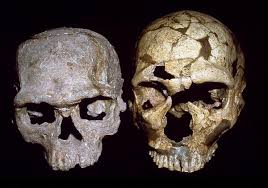 Last month I wrote about Graecopithecus, a possible human ancestor from just after the split with chimpanzees about 7 million years ago. Also last month it was reported that an analysis of new Homo naledi specimens dates the fossils from as recently as 236 thousand years ago. H. naledi share some primitive features that paleontologists thought would date to about 2 million years old, but they also have some more modern features.
Last month I wrote about Graecopithecus, a possible human ancestor from just after the split with chimpanzees about 7 million years ago. Also last month it was reported that an analysis of new Homo naledi specimens dates the fossils from as recently as 236 thousand years ago. H. naledi share some primitive features that paleontologists thought would date to about 2 million years old, but they also have some more modern features.
In April I also wrote about the latest study of H. floresiensis (the Hobbit) showing that it is very likely this was indeed its own species.
All of these news items share a theme – that the picture of the evolution of modern humans from our last common ancestor with chimpanzees is likely much more complicated than we currently know and previously suspected. I think the analogy of a jigsaw puzzle is apt. We are trying to piece together this puzzle, but we don’t know what the final picture looks like. We are connecting lines to the pieces we have, but when we find more evidence we are not just filling in the picture, we are expanding it.
Our map of how human evolution proceeded was just a best fit to the existence evidence. We are still in a stage of our discovery where every new major find alters that best fit. This process was inevitable as we started with a maximally simple (and naive) map – a linear progression from apes to humans. Now we know, as with pretty much every other evolutionary tree, the real map is much more bushy. Adaptive radiation lead in multiple directions simultaneously, only one branch of which survived to be modern humans.
Homo Sapiens from Jebel Irhoud Continue Reading »
May
23
2017
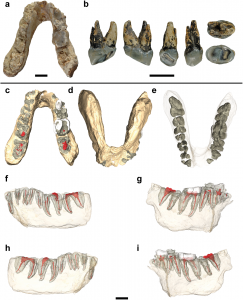 Finding fossils is like finding pieces to a jigsaw puzzle, although we don’t know what the final picture is, or where the edges are, and the pieces themselves are damaged or partial and so it is not always clear if they fit. A piece may seem to fit in one location, but it actually goes somewhere else. Sometimes one section of the puzzle can come together, but you are still not sure where it fits into the greater puzzle. But eventually a clear picture can emerge.
Finding fossils is like finding pieces to a jigsaw puzzle, although we don’t know what the final picture is, or where the edges are, and the pieces themselves are damaged or partial and so it is not always clear if they fit. A piece may seem to fit in one location, but it actually goes somewhere else. Sometimes one section of the puzzle can come together, but you are still not sure where it fits into the greater puzzle. But eventually a clear picture can emerge.
For the last century paleontologists have been trying to piece together the puzzle of human evolution. It’s hard to say how close we are getting to having a reasonably complete picture, because again we don’t know how big the puzzle is or where the edges are. One way to get a sense of where we are is this – with each new fossil find is the puzzle getting bigger and more complex or are we filling in known gaps? It’s definitely some of both, but mainly the puzzle is still getting bigger. We don’t know yet how much we don’t know. We’re not just connecting the dots, we keep adding new dots.
A recent analysis of one potential hominin makes the picture more complex still. Graecopithecus is known from a lower jaw and an upper pre-molar. That is not much, which is why the papers on this fossil all describe is at a “possible” early human ancestor. If Graecopithecus turns out to be legit, then it would be the oldest human ancestor after the split with chimpanzees, and it would move the likely location for that split from sub-Saharan Africa to the Mediterranean.
Continue Reading »
Apr
25
2017
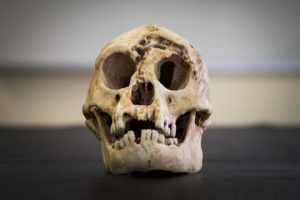 I have been following the story of Homo floresiensis for the last decade, and it is fascinating. The remains of a diminutive humanoid were found on the island of Fores in Indonesia. The remains date to about 54,000 years ago. The findings immediately sparked debate, with two primary schools of thought emerging.
I have been following the story of Homo floresiensis for the last decade, and it is fascinating. The remains of a diminutive humanoid were found on the island of Fores in Indonesia. The remains date to about 54,000 years ago. The findings immediately sparked debate, with two primary schools of thought emerging.
The first hypothesized that H. foresiensis (nicknamed the Hobbit due to their small size) was a new species of hominin, likely evolve from H. erectus and displaying an example of island dwarfism. The second argued that the remains are not a new species at all and represent a pathological H. sapiens (modern human).
The two groups have argued back and forth in the scientific literature over the years. It is, in fact, a great example of the scientific method in action. Each group brought new evidence and a new perspective to bear, and had the burden of proof to demonstrate their hypothesis. They fought it out with science and evidence.
I and many others sat of the sidelines and watched the epic battle of science. I admit I was rooting for H. floresiensis, but we would all have to listen to the evidence, whatever it showed.
It’s also a good example of the limitations of mainstream science reporting. Each time a study was published, favoring one side of the debate or the other, it was reported as if the debate were finally over and now we know the answer. Instead they should have put that one study into context – this is just another round in an ongoing debate. The fight isn’t really over until one side concedes defeat and a consensus emerges. Even then, new evidence may trump the consensus, but at least we have a consensus rather than a controversy.
The New Study Continue Reading »
Mar
27
2017
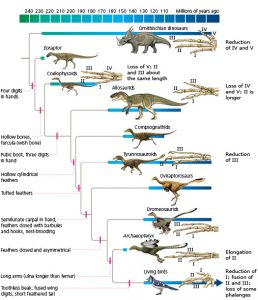 The fossil evidence for the evolution of birds is currently one of the greatest evolutionary stories we have to tell. It is also a home run for the predictive value of evolutionary theory and is a devastating blow to any denial of common descent.
The fossil evidence for the evolution of birds is currently one of the greatest evolutionary stories we have to tell. It is also a home run for the predictive value of evolutionary theory and is a devastating blow to any denial of common descent.
Darwin published On the Origin of Species in 1859. At that time the fossil record was sparse, although it was enough to establish that the forms of living things was changing over geological time. One of the most dramatic gaps in the fossil record at the time was between birds and other vertebrates. It was believed that birds must have evolved from some type of reptile, but the most recent common ancestor was not known.
This was a great test for the new theory of evolution. If evolution were true then birds must have evolved from something else, and therefore the gap between birds and their closest non-avian relative should eventually be filled in by future fossil finds. If evolution is true, those creatures must have existed.
If, on the other hand, some version of creationism were true so that was created close to its current form, then there would not have to be any creatures filling in the morphological space between birds and their closest relatives. Birds would not have any relatives, they would be an isolated group unto themselves.
Continue Reading »
Dec
13
2016
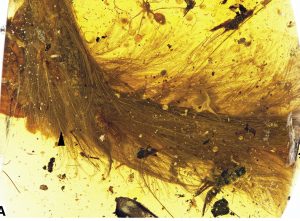 Lida Xing from the China University of Geosciences in Beijing was walking through an amber market in Myitkina, Myanmar when he discovered a rather interesting specimen. The seller believed that the large chunk of fossilized tree sap they were selling contained plant material. Xing recognized that it contained primitive feathers. Even more exciting, those feathers were not connected to a bird ancestor, but to the tail of a dinosaur.
Lida Xing from the China University of Geosciences in Beijing was walking through an amber market in Myitkina, Myanmar when he discovered a rather interesting specimen. The seller believed that the large chunk of fossilized tree sap they were selling contained plant material. Xing recognized that it contained primitive feathers. Even more exciting, those feathers were not connected to a bird ancestor, but to the tail of a dinosaur.
A scientific analysis of that specimen has now been published in Current Biology.
This is a tremendous specimen for a number of reasons. Scientists interested in the evolution of feathers have been trying to piece together the developmental steps that occurred and in what order in order to transform scales into feathers. Developmental biology itself provides some clues – the path that feathers take when they develop in the embryo likely reflect their evolutionary history. It would be nice, however, to confirm this hypothesis with actual specimens.
Up until now paleontologists have had two kinds of fossil feathers. The first is feather impressions associated with fossil specimens. The advantage of this kind of evidence is that we know exactly what species the feathers belong to and so they can be placed in a phylogenetic tree of feathered dinosaurs, both avian and non-avian. The disadvantage is that the feather impression are compressed, so the three-dimensional information may be lost, and they often lack fine detail.
Continue Reading »
Sep
19
2016
Researchers at Harvard did a clever thing. They created a giant plate on which to grow bacteria, and included in the plate increasing concentrations of an antibiotic as you moved toward the center. They then plated bacteria on the outer edges and made a time-lapse video of the bacteria growing.
The end result was a video showing the evolution of progressive antibiotic resistance in the bacteria. You can actually see adaptive radiation, as the bacteria push up against the boundary to the next higher concentration of antibiotics, then multiple locations start to spawn new colonies spreading in the next zone.
The researcher made some more nuanced observations as well. For example, the bacterial grow slowed with new mutations, meaning they sacrificed something with the resistance mutation, but then they sped up again as they further evolved. Further, the most resistant bacteria were often not at the leading edge but were stuck behind less resistant bacteria.
Continue Reading »
Aug
05
2016
 It is my universal experience, after more than thirty years of confronting various forms of evolution denial or creationism, that creationists simply do not understand evolution. If any do understand it, they pretend not to. I guess they have no choice – they are motivated to deny an established scientific theory. They need to pretend they know better than the world’s experts, or that the world’s experts are lying and deceitful.
It is my universal experience, after more than thirty years of confronting various forms of evolution denial or creationism, that creationists simply do not understand evolution. If any do understand it, they pretend not to. I guess they have no choice – they are motivated to deny an established scientific theory. They need to pretend they know better than the world’s experts, or that the world’s experts are lying and deceitful.
Mike Pence is a run-of-the-mill creationist. His denial of evolution is unremarkable and unimaginative, but now he is running for Vice President so his views serve as a ripe target for criticism. In a speech before the House he decided, for some reason, to go on a rant against evolution. For those who are interested, it is a good opportunity to play “name that logical fallacy” and you may want to watch the video and count the errors before reading ahead.
Pretty much everything Mike Pence says in the speech is wrong or misleading, except for trivial facts. He starts by setting the stage with Darwin publishing On the Origin of Species and presenting the theory of evolution. That evolution is just a “theory” is a main theme of his speech, which I will get to in a moment, but first he follows up by saying that Darwin expected his theory to be proven correct by the fossil record. He concludes that Darwin did not live to see this happen, and neither have we.
Is Evolutionary Theory Proven? Continue Reading »
 The fight over science in public education continues, and if anything picked up considerably in 2017. Earlier in the year Nature reported on various state laws designed to water down science education or allow for equal time to be given to unscientific views. They report:
The fight over science in public education continues, and if anything picked up considerably in 2017. Earlier in the year Nature reported on various state laws designed to water down science education or allow for equal time to be given to unscientific views. They report:
 Junk DNA, put simply, is those parts of the genome (human or otherwise) that have no known function. The human genome has about
Junk DNA, put simply, is those parts of the genome (human or otherwise) that have no known function. The human genome has about  Last month
Last month  Finding fossils is like finding pieces to a jigsaw puzzle, although we don’t know what the final picture is, or where the edges are, and the pieces themselves are damaged or partial and so it is not always clear if they fit. A piece may seem to fit in one location, but it actually goes somewhere else. Sometimes one section of the puzzle can come together, but you are still not sure where it fits into the greater puzzle. But eventually a clear picture can emerge.
Finding fossils is like finding pieces to a jigsaw puzzle, although we don’t know what the final picture is, or where the edges are, and the pieces themselves are damaged or partial and so it is not always clear if they fit. A piece may seem to fit in one location, but it actually goes somewhere else. Sometimes one section of the puzzle can come together, but you are still not sure where it fits into the greater puzzle. But eventually a clear picture can emerge. I have been following the story of Homo floresiensis for the last decade, and it is fascinating. The remains of a diminutive humanoid were found on the island of Fores in Indonesia. The remains date to about 54,000 years ago. The findings immediately sparked debate, with two primary schools of thought emerging.
I have been following the story of Homo floresiensis for the last decade, and it is fascinating. The remains of a diminutive humanoid were found on the island of Fores in Indonesia. The remains date to about 54,000 years ago. The findings immediately sparked debate, with two primary schools of thought emerging. The fossil evidence for the evolution of birds is currently one of the greatest evolutionary stories we have to tell. It is also a home run for the predictive value of evolutionary theory and is a devastating blow to any denial of common descent.
The fossil evidence for the evolution of birds is currently one of the greatest evolutionary stories we have to tell. It is also a home run for the predictive value of evolutionary theory and is a devastating blow to any denial of common descent. Lida Xing from the China University of Geosciences in Beijing was walking through an amber market in Myitkina, Myanmar when he
Lida Xing from the China University of Geosciences in Beijing was walking through an amber market in Myitkina, Myanmar when he It is my universal experience, after more than thirty years of confronting various forms of evolution denial or creationism, that creationists simply do not understand evolution. If any do understand it, they pretend not to. I guess they have no choice – they are motivated to deny an established scientific theory. They need to pretend they know better than the world’s experts, or that the world’s experts are lying and deceitful.
It is my universal experience, after more than thirty years of confronting various forms of evolution denial or creationism, that creationists simply do not understand evolution. If any do understand it, they pretend not to. I guess they have no choice – they are motivated to deny an established scientific theory. They need to pretend they know better than the world’s experts, or that the world’s experts are lying and deceitful.




